
The Ultimate Singapore Food Guide: 23 Dishes to Try and Where
Food is at the heart of Singapore’s identity. It is often considered the national pastime, an obsession, a frequent topic of conversation, and a unifying cultural thread. You’ll often hear people discussing the best spots for Singaporean food, arguing about the top chwee kueh, the best Laksa stall in Katong, the greatest hawker center, or the finest Kaya toast joint. The entire country takes pride in its knowledge and appreciation of good food. Eating is taken seriously in this island nation of food lovers, and with great emphasis on eating comes a focus on quality—fresh, affordable food in hawker centers. Some of these stalls have even been awarded Michelin stars! You’ll find dishes from a range of cuisines catering to the diverse Singaporean population.
It’s no surprise if you find yourself eating through your vacation in Singapore; there’s nothing else better to do. But what Singapore food should you try with the amount of eateries and dishes to choose from? Eating is also one of my beloved hobbies, and I’ve tried so many unique dishes and snacks that you should try. If you visit Singapore, you’ll discover local favorites that aren’t as globally renowned but no less important than the famous Singaporean dishes.
What is Singapore food?
Like the country, a variety of ethnic cuisines influence Singaporean cuisine as a result of political, economic, and social changes in history. Like the Singaporean population, the cuisine includes influences from Chinese, Malay, Indian, Indonesian, and Teochew cuisines. As a result, Singaporean food is full of flavor and variety with various flavors, spices, and ingredients used. Many dishes are fragrant and aromatic, using herbs like black pepper, turmeric, cumin, chili, garlic, onion, ginger, lemongrass, coriander, etc. Dishes range from strong-flavored curries, soups, and noodle dishes to nourishing broths, juices, and savory cakes. From spicy laksa to heartwarming bak kut teh to delicious roti prata, Singapore food never runs short of fragrance and flavor.
As previously mentioned, eating is one of Singapore’s national hobbies. Because Singapore is a melting pot of different cultures, food is the national identity that ties them all together. Food stalls, restaurants, and hawker centers are busy all day with hungry Singaporeans meeting friends or family for food. Eating weaves the social fabric and national identity in Singapore where, according to a Rakuten Insight on Singaporean dining out habits in 2022, half of the country eats out weekly, and a quarter dine out daily. Hawker centers, or causal food halls, are a vital hang-out place in Singaporean society, being the heartbeat and lifeblood of Singapore food.
How Much is Food in Singapore?

Most Singapore food is cheap. Food stalls at hawker centers are much more affordable than mid-tier establishments or restaurants. A full meal at a hawker center will cost, at most, around 5-7 SGD. You can get fresh juices and snacks for about 2-3 SGD. You can easily spend 20 SGD on three meals per day by eating only at hawker centers. It’s an economical and tasty method of fueling in Singapore.
Going to cafes, restaurants, or even fine dining establishments will cost more and more on par with American or European prices. An iced latte from a specialty coffee shop will be about 6 SGD, and a meal at a restaurant could be 20-30 SGD per person. Luckily, most Singaporeans eat at casual food halls rather than a nice restaurant daily. It’s economical for locals, too! But don’t let a price tag prevent you from trying different dishes and establishments. It might be nice to have a variety of dining experiences in Singapore. However, you’ll really feel and see what Singaporean life is like at the hawker centers. They’re simple, upfront, and a shared experience.
Singaporean Dining Etiquette
There are some dining rules in Singapore that you should know before you go to eat out with friends.
- Food is mainly served family style, meaning that dishes are shared between everyone at the table.
- If you are eating with your host, letting them order food for the table unless asked is considered polite.
- If you’re dining with someone much older than you, let them eat first. It’s polite!
- At hawker centers, always clean up after yourself. There are self-bussing stations to return plates and utensils you’ve used. While some workers help wipe down tables after eating, it makes their life easier if you bus your own table.
- To save a seat at a table, put a napkin down. That’s the universal Singaporean sign for “I’ve claimed this table.” Likewise, if you see a table that has napkins on it, it’s likely taken already, so don’t sit there! You’ll get a rude awakening, haha.
- Restaurants do not expect tips in Singapore, although it is welcome if you get extraordinary service.
- If you have leftover food or food waste after eating, leave it on your plate and not on the table. It’s helpful for servers once you’re done eating.
Now that you know a little more about Singapore food culture and how to eat out, here are 36 Singaporean dishes you must try and where you should eat them! Number 3 is a personal favorite, where my Singaporean friend said, “I’ve never met anyone who’s loved it as much as you.”
Singapore Food Guide: 23 Must-Try Dishes and Where
There are six main categories that define Singapore food: meat, seafood, rice, noodles, dessert, and snacks.
However, for easy organization, I’m going to organize the following Singapore food list into these meal categories:
- Breakfast
- Meals
- Dessert
- Snacks
- Beverages
for easier reading. You can jump to each section by clicking the respective keyword.
Breakfast
1. Ya Kun Kaya Toast
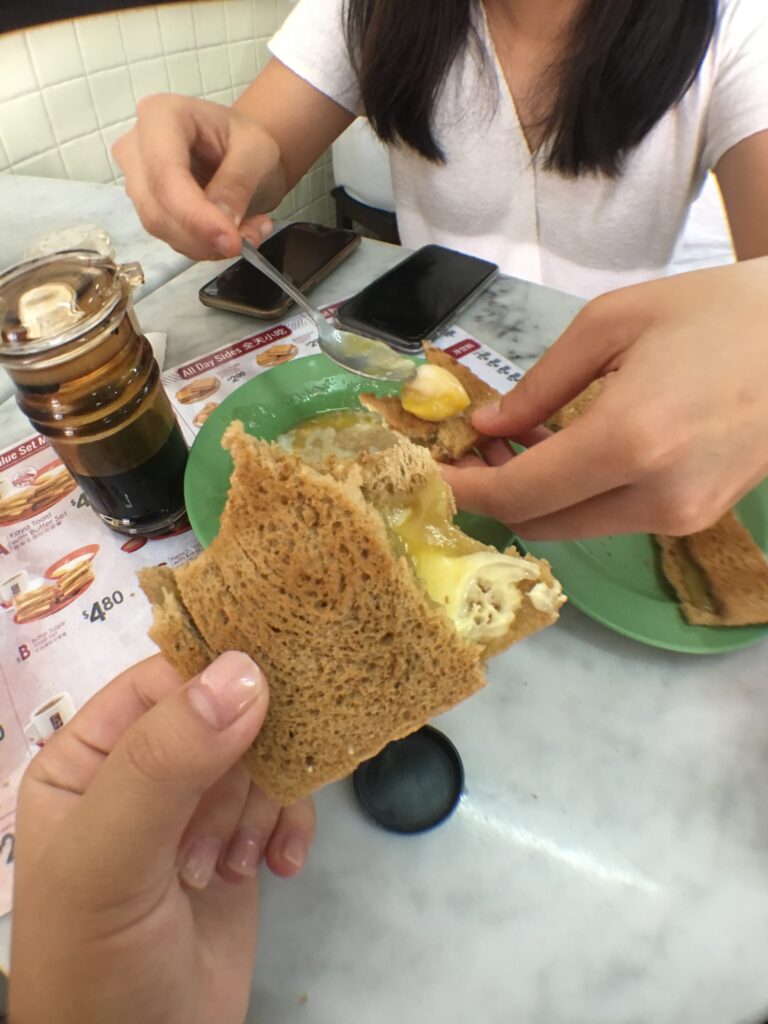

The iconic Singaporean breakfast: toast, kaya jam, and soft-boiled eggs.
One of the most popular Singaporean breakfasts out there. You can find it at malls, many streets, even the airport! It’s a classic combination of sweet, salty, soft, and crunchy that every Singaporean eats. Kaya toast is also one of the most Singaporean foods out there, actually invented in the country! It’s believed that Hainanese immigrants working at the Port of Singapore adapted what they served on British ships to the now iconic Kaya Toast. The first establishment to sell kaya toast in Singapore opened in 1919, called Kheng Hoe Heng Coffeeshop, now Killney Kopitiam, and is the oldest Hainanese coffee shop in Singapore.
However, Kaya Toast didn’t take off until the 2000s with the rapid expansion of outlets from Ya Kun and Killey Kopitiam in shopping malls. Now, you can find a variety of chains and coffee shops selling their version of Kaya Toast.
There are many variations of Kaya Toast, but they all have these three key components: a delicious carb, kaya jam, and soft butter. Kaya jam is a sweet spread made of coconut milk, eggs, and sugar. Sometimes, pandan is added as well. The carb the jam is put on ranges in texture and size: thin toasted bread, lightly toasted soft bread, crackers, steamed bread, biscuits, and french toast. But of all the possibilities, the most famous is the thin toasted bread with kaya jam from Ya Kun Kaya Toast. It’s crunchy, sweet, and light. It pairs great with a soft-boiled egg doused in soy sauce and white pepper.
My Experience
It’s one of my favorite breakfasts and snacks to eat in Singapore, and I always get Ya Kun Kaya Toast on my trips. I even bring jars of their kaya jam back home to take the experience back home with me. My first time trying kaya toast was at the Ya Kun Kaya Toast outlet in Chinatown, and I remember thinking, how is this amazing combination possible?! Since then, it’s been a must-eat in Singapore.
Where to Try: Ya Kun Kaya Toast is my favorite place to get kaya toast. You can order it in a set with kopi teh or by itself. It’s probably the most well-known place to get it amongst tourists and locals alike.
2. Roti Prata
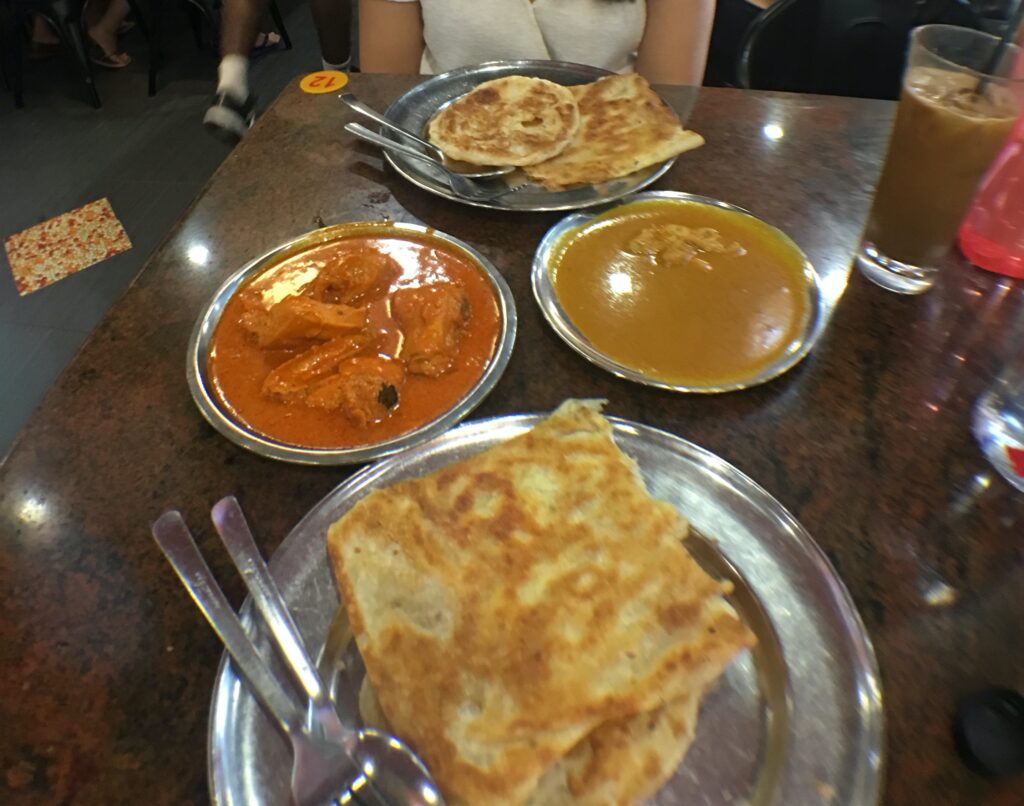
Breakfast of champions that’s finger-licking good.
Who doesn’t want to start off their day with a crispy and soft bread fried in ghee? Indian immigrants introduced roti prata to Singapore, and it has since become an integral part of Singaporean cuisine. Aside from kaya toast, roti prata is probably the most common and popular breakfast food to eat in Singapore. It’s normally served plain with curry you dip the flatbread in. Roti prata is shatteringly crisp on the outside but chewy and stretchy on the inside with a satisfying chew. The ghee leaves a slightly sweet and fragrant buttery taste in your mouth afterward. Nothing hits the spot like roti prata at all hours of the day (or night).
While the most popular prata is the plain one, you can find filled prata with savory or even sweet toppings. You can add to your order depending on how hungry you are. Roti prata is meant to be eaten with your hands, and it’s fun to rip the fresh prata and watch the steam rise from inside—fresh roti prata is the best! It’s also fun to watch the chefs twirl and stretch the dough paper thin. From Hindi/Malay to English, Roti means ‘bread,’ and prata or paratha means ‘flat’ or ‘thin,’ which is fitting! Some say it originated in Punjab, and others from Muslim conquerors in India. But regardless of its origin, it’s a dish enjoyed widely in South and Southeast Asia.
Where to Try: Casuarina Curry is known for its light and crispy prata and is a local spot frequently busy during breakfast. They opened in 1992 and have been fueling Singaporeans with fresh prata and more for more than 30 years. They also have a large menu, so there’s something for everyone.
3. Chai Tow Kway (Carrot Cake)

This is unlike any carrot cake you’ve had.
Despite the name, this dish is not made with carrots! In Hokkien, chai tow means ‘radish’ or ‘carrot,’ and kway means ‘cake.’ Teochew immigrants brought over char kway, which is simply rice cake fried in dark soya sauce. In the 1960s, Ng Soik Theng, a Teochew hawker, claimed to be the first to make the carrot cake known today by adding white radish to char kway. There are also two types of chai tow kway: white and black. While Ng Soik Theng claims the black version, another hawker claims the white.
The core ingredients of carrot cake are rice flour and white radish, which are cubed, steamed, and then fried with garlic, eggs, and preserved radish. The result is a mixture of soft rice cakes and radishes that are crispy on the outside and coated in a savory topping that is sweet and salty. Between the white and black versions, the only difference is the use of dark soya sauce. It’s another popular Singaporean breakfast that is tasty and filling.
Where to Try: Try carrot cake at the legendary Bukit Merah View’s Carrot Cake, which has been in business for over 70 years. Unlike other stalls, they make their rice cakes from freshly milled rice, which makes it soft and chewy.
Meals
4. Hainanese Chicken Rice
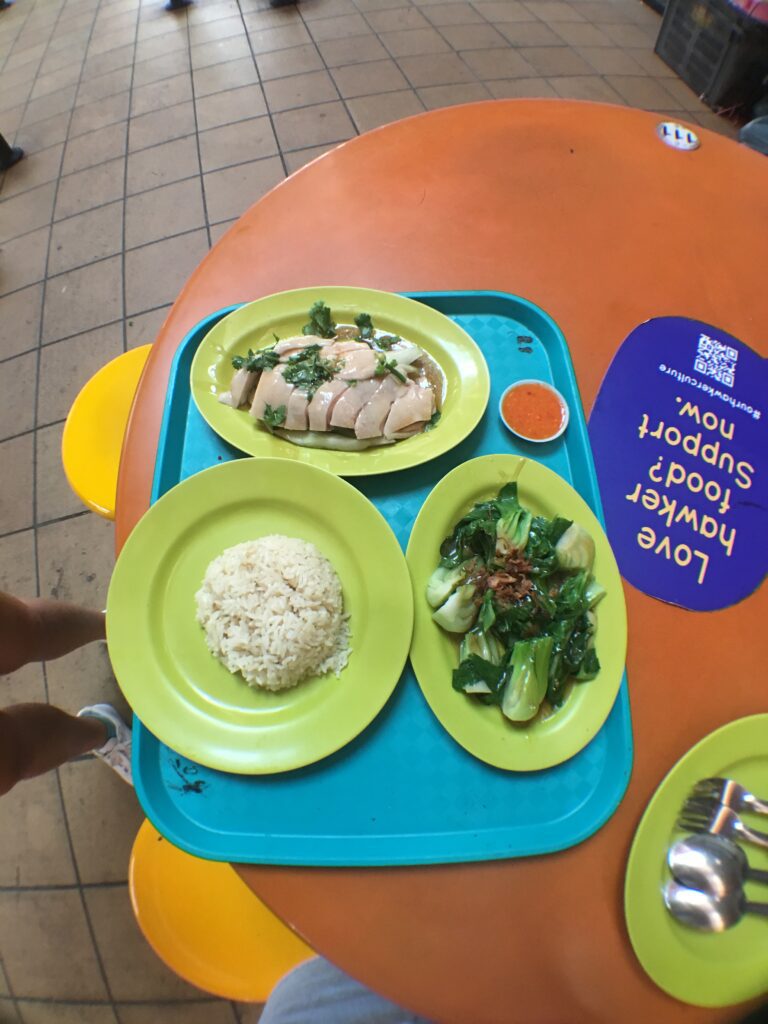

The unofficial national dish of Singapore.
Smooth, tender chicken over a bed of savory rice with aromatic chili sauce and a side of cucumbers or bokchoy. Hainanese immigrants created this dish, inspired by the Hainan dish Wenchang chicken, which dates back to the Ming Dynasty. Wenchang chicken and Hainanese chicken rice are incredibly similar, but the one thing that sets them apart is the fragrant chili sauce/topping that comes with the Singaporean version. The chili sauce is made with red chili, ginger, salt, sugar, lime juice, garlic, and chicken broth. It’s got a slightly chunky texture that pairs perfectly with the soft poached chicken. Much like chili crab, the sauce is one of the most yummy parts of the dish.
Singapore doesn’t have an official national dish, but Hainanese chicken rice has been unofficially claimed as the national dish by locals, bloggers, news outlets, and more. It’s a hearty, comforting dish that you can rely on time and again. It’s the dish you pick after not knowing what you want to eat, faced with the countless options of hawker stalls. You’ll see people eating chicken rice at all times of day, for lunch, at the mall for a shopping break, an afterschool snack, etc. If hawker centres are the social hubs for eating, then Hainanese chicken rice is the conversation of choice.
Prices
Chicken rice can be as affordable as 3.50 SGD a serving, especially at hawker centres. However, that portion won’t be enough to fill you up, and a single serving will be 5 SGD from the food stall. You can find chicken rice in many restaurants and cafes, but it will probably be a little more expensive than at the hawker centre. You’ll find chicken rice in almost every shopping mall food court as well. Chicken rice in formal establishments will be around 10-12 SGD.
Where to Try: Tian Tian Hainanese Chicken Rice 天天海南鸡饭 at Maxwell Food Centre is the most famous place for Hainanese chicken rice. It’s famous even beyond Singapore, as it won several Bib Gourmand awards from Michelin. You know it’s popular when the owners say, “Please come early to avoid disappointment.” LOL.
5. Chili Crab

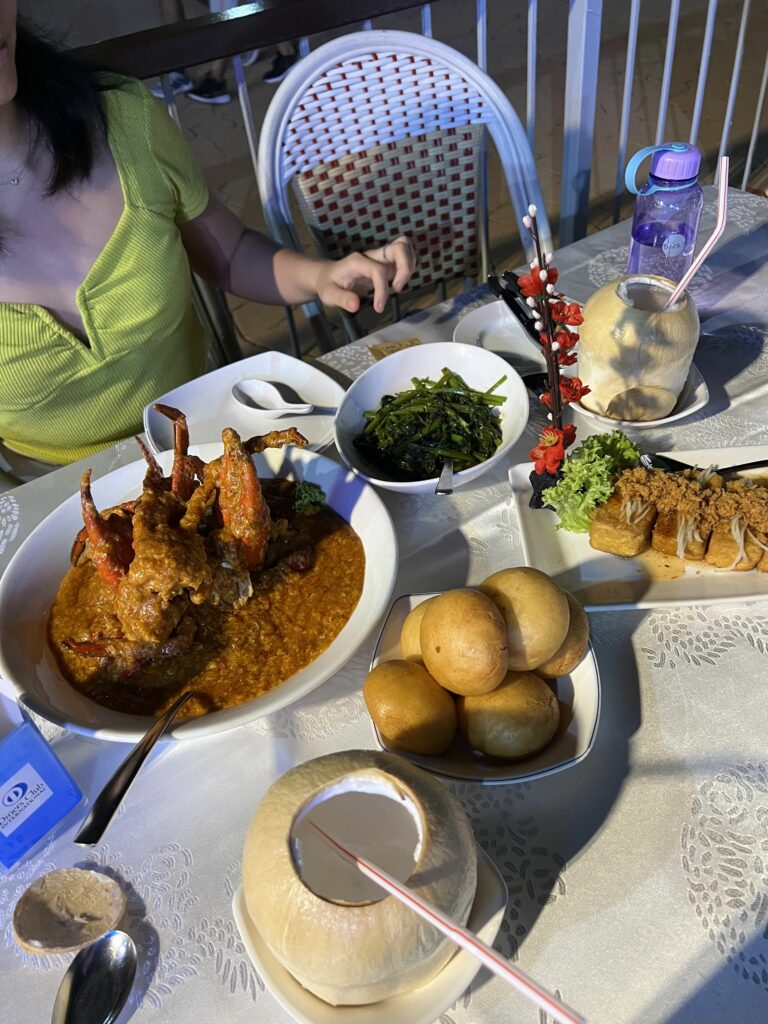
Where the sauce makes the dish.
One of the top contestants for Singapore’s national dish, chili crab is one of the most popular dishes to try amongst tourists. Red, juicy crabs are steamed and cooked in a saucy gravy made with sweet, spicy chili, ketchup or tomato sauce, soy sauce, fermented soy or shrimp paste, and a few other key Singaporean spices. The dish is served with rice or fluffy buns on the side, which are dipped into the sauce and eaten with the crab. It’s sweet, savory, and umami from the seafood. This combination of flavors makes it an incredibly addicting but also messy dish that keeps you coming back for more.
The dish originated from a pushcart in 1956 by Madam Cher Yam Tian and her husband Lim Choo Ngee, who began selling stir-fried crabs mixed with chili and tomato sauce as an experiment of cooking crabs. They sold it by Kallung River and became so popular they opened their own restaurant.
Chili crab isn’t a cheap dish by any means, and it can run around 30-40 SGD, depending on how large the portion is. However, it’s meant to be shared by multiple people. When I first tried this dish, I was expecting it to be more savory than sweet, so it took me a while to get used to it. But the next time I try it, I can see myself getting addicted. It’s so hearty and flavorful!
Where to Try: Long Beach Restaurant is one of the most famous places to try chili crab. They’re known for both their chili and black pepper crab, the former renowned for its addicting sauce.
6. Laksa

One of the most addicting soups I’ve had in my life.
Laksa is a spicy, fragrant curry noodle soup made with a coconut milk soup with shrimp paste, ginger, lemongrass, shallots, chilis, and fresh aromatics. It’s served with lime wedges, shrimp, fried tofu, bean sprouts, and boiled egg. If I could have one noodle soup for the rest of my life… it would probably be laksa. It’s slightly sweet, creamy, savory, spicy, and sour. It has all the flavors that make food taste incredible: salt, fat, acid, and heat. The resulting soup is so addicting, and the toppings, especially the fried tofu, soak up all the liquid and become a flavor bomb.
Singaporeans and Malaysians always fight about which version of laksa is better: Asam laksa, Siamese laksa, or nonya laksa. Each one uses a slightly different base, from tamarind paste to fish. Laksa, in general, is from Peranakan cuisine, which is a fusion of Malay and Chinese culture. It’s easy to see how this dish is a combination of Chinese noodle soups and Southeast Asian curries.
Laksa blew up in popularity, originating from the Katong neighborhood in Singapore, which is known to be a hub of Peranakan heritage. In the 19th century, Chinese immigrants moved to Singapore for trade and married locals from Southeast Asia. The households fused Chinese with Malay or Southeast Asian cuisine, innovating dishes like Laksa or Hee Pio (Fish Maw) Soup. As a result, some of the best laksa is found in Katong.
Where to Try: 328 Katong Laksa is the most famous place to get laksa, more recently known for the restaurant that beat Gordon Ramsay himself in a cook-off. It also won a Bib Gourmand award in 2017. Try their soup that will have you salivating with every bite.
7. Bak Kut Teh
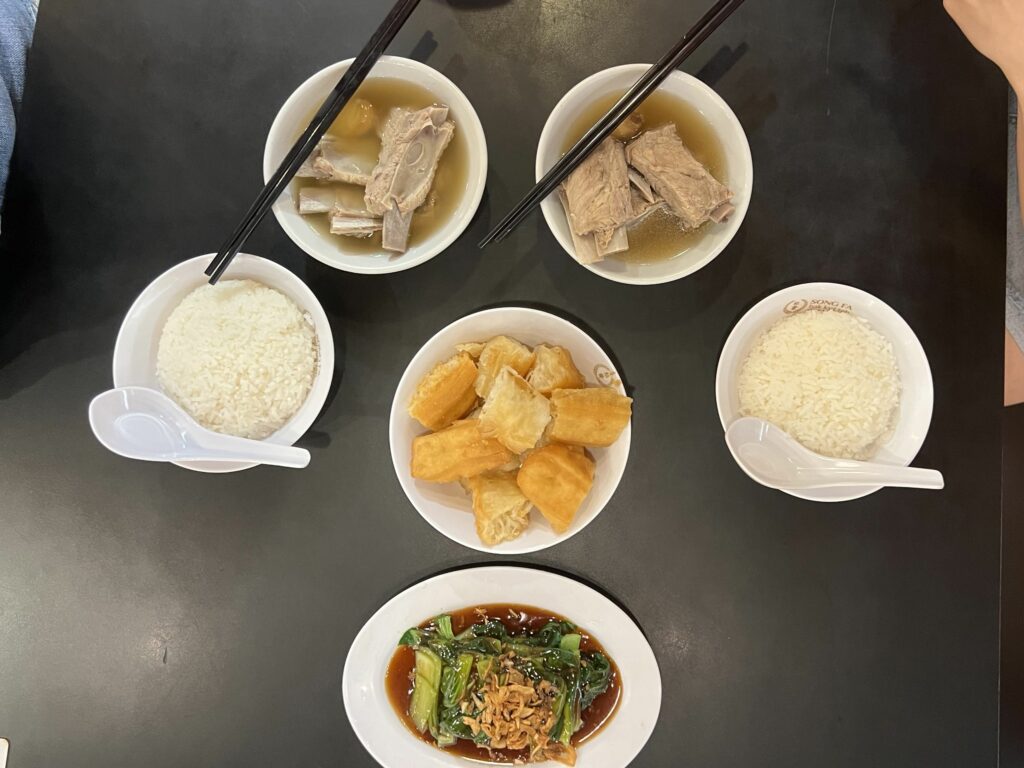
Meat bone tea…?
Bak kut teh in Hokkien or Fujianese means meat bone tea or pork rib tea. Its origins are in China’s Fujian province and derives from the Fujian dish niu pai or beef rib. The invention of the dish is unclear, but it’s said that it was first made to feed hungry workers at the Malaysian port who had no time for nutrition. Bak kut teh, similar to chili crab, was sold along the Singapore River by immigrants after World War II and instantly became a hit. Now, bak kut teh is a beloved soup many locals enjoy when they are sick or want something comforting on a rainy day.
The soup is rich in flavor because the pork ribs simmer in broth with an array of spices like fennel seeds, star anise, cloves, cinnamon, garlic, and dang gui for hours. The meat becomes incredibly succulent and tender, and the broth infuses with the meaty flavor and the aromatic spices. Bak kut teh is usually eaten with rice, you tiao or fried Chinese donuts, and a veggie. At a restaurant, you normally only order the soup and order the side dishes separately. There’s normally white pepper at the table to add to your soup for a delicious peppery kick. Additionally, when you eat it at a restaurant, you’ll often find a waiter walking around with extra hot broth in a kettle that you can ask to top up for free. Neat!
My Experience
I had it for the first time on my second trip to Singapore in March 2023, and I see why it’s a Singaporean comfort food. Soup, by default, is already nourishing, and on top of a flavorful, warm soup, you have basically 4 out of 5 food groups on the table. The broth is incredibly addicting and is so yummy when eaten with rice. The rice gets coated in this amazing broth, and it makes you keep asking for more broth, haha. It’s one of my favorite dishes now!
Where to Try: My (and many locals) favorite place to eat bak kut teh is at the Michelin Guide Bib Gourmand, awarded Teochew-style Song Fa Bak Kut Teh. Its Teochew-style broth is garlicky, peppery, and incredibly addicting.
8. Fish Bee Hoon Soup
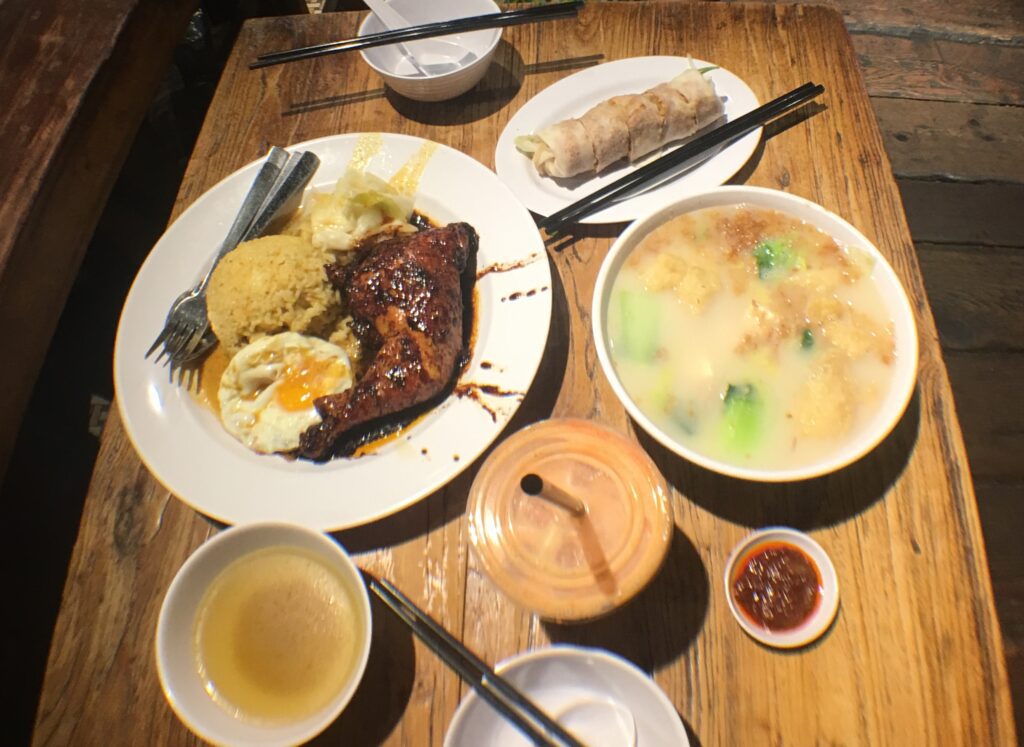
Milky fish soup that is savory and comforting.
You might be wondering what the heck bee hoon means. Bee hoon means rice noodles or rice vermicelli in Teochew or Hokkien. The broth is famous for its milky appearance, with some stalls adding in evaporated milk and others omitting it. It’s a point of debate for many sellers of fish bee hoon soup, where some enjoy the “pure” milky broth without milk and others with it. You can achieve a milky broth without evaporated milk simply by simmering the fish bones and head in water for long periods of time, similar to tonkatsu ramen broth. Because of that, this soup is coined the original collagen soup.
The soup is made with fish bones and boiled with a variety of aromatic seasonings like garlic, ginger, white pepper, and Chinese cooking wine. Then, it’s served with fried fish fillet slices, bokchoy, tomatoes, and bee hoon or rice vermicelli noodles. You always have to start eating this dish by sipping the soup first, which is light, slightly creamy, savory, and slightly garlicky. It’s clean, natural, and refreshing. Like fried tofu, the fried fish soaks up the broth and becomes a flavor bomb in your mouth. It’s the perfect comfort soup.
Don’t be off put by the addition of milk in this soup; it adds a dimension of flavor and creaminess that enhances the flavor of everything else!
Where to Try: Jin Hua Fish Head Bee Hoon/Sliced fish Bee Hoon in Maxwell Food Centre is a popular local spot for this dish. You can customize how much milk you want in the broth, which is what they’re known for. Noodles are made fresh to order, and the portions are generous!
9. Hokkien Mee
Chinese lo mein’s flavorful cousin.
The Hokkien Mee directly translates to Hokkien or Fujian noodles. While the name may be simple, the dish is far from it. Hokkien mee is an egg noodle dish stir-fried in an aromatic prawn and pork broth that’s been simmering for hours. The main seasoning is dark soy sauce, which is sweet and salty. The noodles are flavorful, saucy, seafoody, meaty, and balanced with the lime and chili served on the side. Like many dishes in Singapore, Hokkien mee has so many different flavors that make for an addicting Singapore food.
According to Singapore Tourism, Hokkien mee used to be known as Rochor mee because it was first sold at Rochor Road. Hokkien noodle factory workers in post-war Singapore gathered at Rochor Road in the evenings to fry the excess noodles from the factories. There is also a Peranakan version that features a more gravy-like sauce and sambal in the noodles.
Hokkien mee noodles are found in every hawker center, as it’s one of the most popular hawker dishes. It’s usually eaten before or after a night out or for dinner! It’s also a dish that’s easy to make at home and can be customized to your liking.
Where to Try: Geylang Lorong 29 Hokkien Mee (they just relocated) is one of the most famous spots for Hokkien Mee. It’s family-run, with the late-owner passing away last November. The late owner also has a brother who runs another popular Hokkien Mee shop, Swee Guan Hokkien Mee.
10. Nasi Ayam Bakar/Panggang
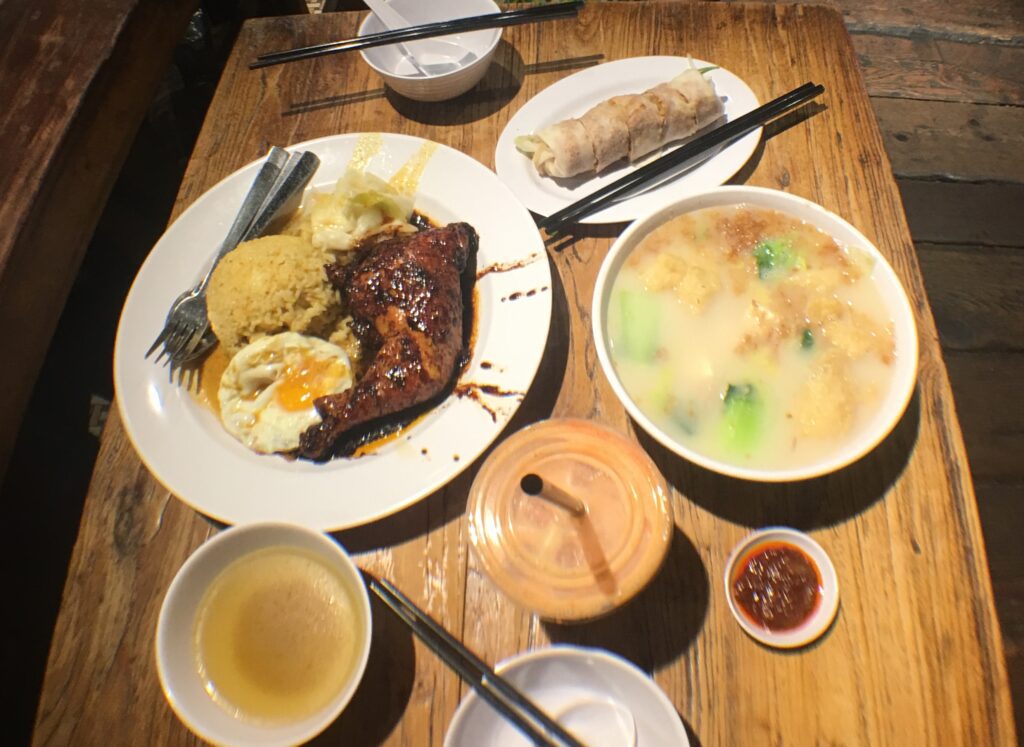
It’s no surprise an Indonesian dish is popular in Singapore.
This Indonesian grilled chicken dish is incredibly loved in Malaysia, Singapore, and Indonesia. The name ayam bakar literally means “grilled chicken” in Indonesian and Malay, and nasi means rice. The chicken is marinated in kecap manis, or sweet soy sauce, and coconut oil. Then, it’s charcoal grilled in a spice mix called bumbu, which commonly includes ginger, nutmeg, pepper, turmeric, and galangal. After grilling, the chicken forms a delicious crust caked with flavor that retains all the chicken juices for a moist and flavorful chicken.
When ordering nasi ayam bakar, it usually comes with rice, an egg, and veggies, and all served in a banana leaf, paper, or plate. You can get different types of rice, like coconut milk rice, and also different types of veggies as well. You’ll also get a sambal served with this dish as well. It’s flavorful with every bite, and the textures work well together. It’s also filling, making the perfect dish to share with friends or family.
Singaporeans love Hainanese chicken rice, so it’s no surprise that this Indonesian version is popular as well. You can find ayam bakar served in almost every hawker centre and mall food court.
Where to Try: My favorite place for ayam bakar is Riverside Indonesia BBQ at FoodRepublic in VivoCity. It’s a stall in a shopping mall food center that is unsuspecting but so good. The chicken is moist and their ayam panggang set is to die for—grilled chicken, steamed rice, a fried egg, and steamed (but still crunchy) veggies.
11. Char Kway Teow
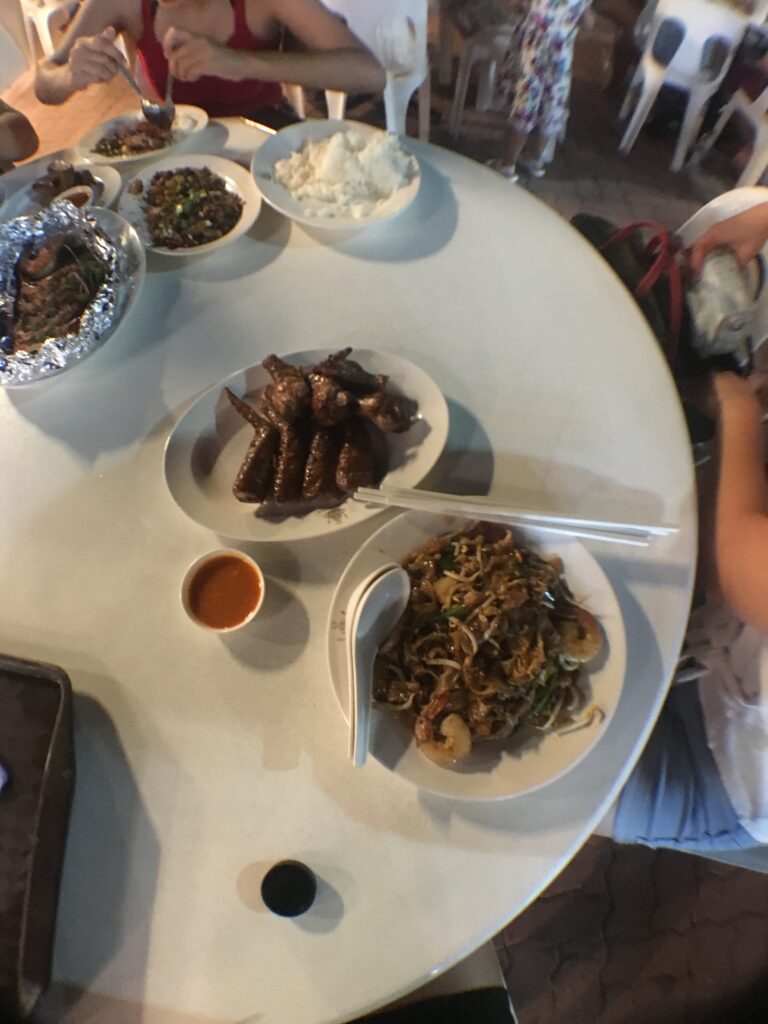
Pad Thai’s Singaporean cousin.
Not to be confused with Chai Tow Kway, char Kway Teow is a stir-fried flat rice noodle dish with eggs, beansprouts, scallions, and sometimes Chinese sausage or shrimp. It’s traditionally stir-fried in pork fat in a wok, giving a reputation of being unhealthy. This dish originated with poor Chinese laborers in Southeast Asia who created this dish using leftover and affordable ingredients to supplement their income. The use of pork fat made it so it was a cheap source of energy and popular with other laborers looking for a filling meal after work.
In Singapore, this is a popular and inexpensive breakfast or lunch in hawker centres. This dish is so popular and widespread that there are dozens of versions. There’s the straightforward and simple version with shrimp and egg, which you’ll find at hawker centres. You’ll find more luxurious versions with more expensive seafood like lobster in restaurants. For those who can’t consume pork, char kway teow is prepared without pork lard. There’s even a Hong Kong version made with char siu!
Char kway teow has a unique taste. The flavor is a combination of sweet, dark soya sauce, garlic, and lard. But most importantly, there is smoky aroma from wok hei, or “breath of the wok,” which is a Chinese stir-fry technique done in a wok over extremely high heat. The result is a smoky stir-fried noodle that is sweet, salty, oily, and aromatic.
Where to Try: Try char kway teow at No.18 Zion Road Fried Kway Teow, a local favorite that has fragrant noodles made to order. The Michelin Guide awarded it a Bib Gourmand, too!
Snacks
12. Satay
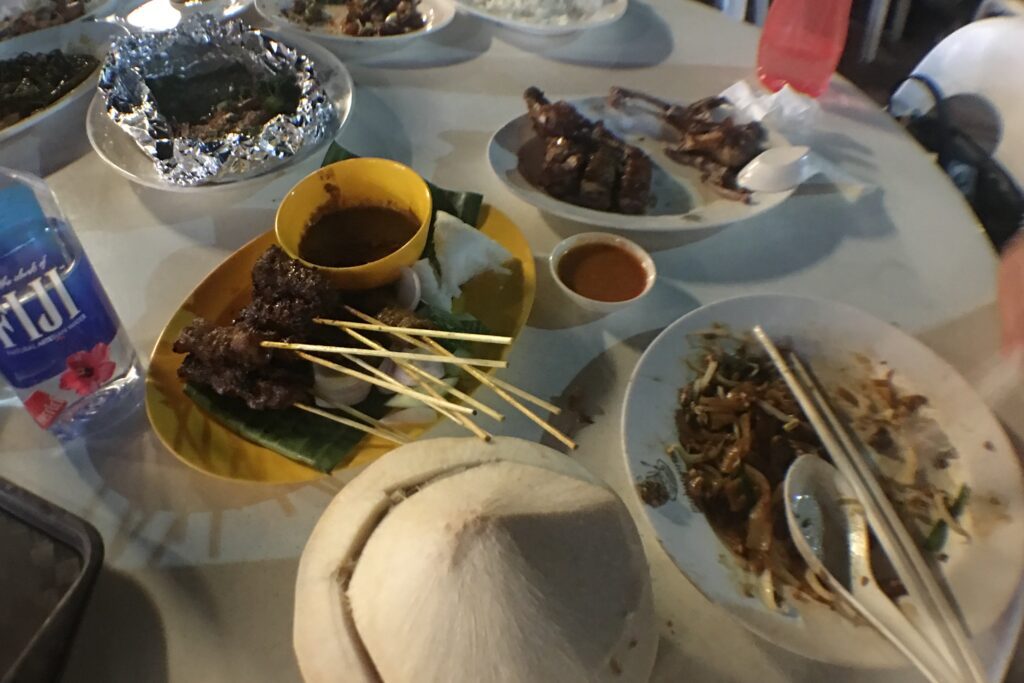
Can’t go wrong with barbequed meat on a stick.
Satay is the quintessential Singapore street food and a staple for communal dining. It’s said that satay is inspired by Middle Eastern kebabs, brought to Malaysia by Arab conquerors, which then found its way to Singapore through Malaysian immigrants. Satay is marinated meat grilled on bamboo skewers, which is slightly sweet and aromatic. Some of the flavors in satay include garlic, onion, lemongrass, soy sauce, cumin, and more. It’s incredibly flavorful and juicy, usually served with a peanut dipping sauce and fresh veggies.
On a hot, humid night, when you’re hanging out with your friends and you want a bite to eat, satay is the answer. It’s one of the best foods to eat communally, as you can pick the meats and the number of skewers for the group. There’s truly something for everyone, and it is a great appetizer while you decide what else to eat next. It’s also incredibly economical, with skewers costing about 50 cents to a dollar depending on the meat. There’s nothing more satisfying than digging into charcoal grilled meat that’s straight off the grill and dripping in juice.s
Where to Try: Syifa’ Satay in Makansutra Gluttons Bay grills their satay with 12 different spices and serves them on a banana leaf on a plate. It comes with peanut sauce and cucumbers, and it’s a delight.
13. Popiah

Healthy Chinese burrito.
This dish is popular amongst the Chinese, Fujian, and Teochew communities in Singapore. It’s a fresh (non-fried) spring roll made with a thin wheat crepe that wraps thinly cut vegetables and your choice of protein. Popular proteins found in popiah include tofu, shrimp, pork, and crab. You’ll also find peanuts, eggs, bean sprouts, and jicama as well! It’s normally dipped in hoisin and chili sauce and is a popular street food snack.
Because popiah is packed with vegetables, it’s known as a healthy dish. Although, some versions sold at the hawker centre are not as healthy because some ingredients are cooked in lard or oil. Each bite also has a bunch of textures and flavors, making it an enjoyable experience. Popiah is usually bursting to the seams and incredibly filling. It’s also a great way to pack a bunch of vegetables into your diet, haha.
This dish is frequently eaten during celebrations, especially during Qingming, which is the tomb sweeping day. According to legend, the prince of the Jin Kingdom accidentally burned his savior to death, so on his tomb-sweeping day, fire is forbidden. Thus, cold foods are eaten during Qingming, with Popiah being one of them.
Where to Try: Try popiah at Good Chance Popiah Eating House. They’re unique because you roll your own popiah! It’s a fun, interactive experience, and it tastes good.
14. Lao Ban Soya Beancurd


The silkiest, softest tofu pudding I’ve ever had—it’s unreal.
Freshly made beancurd that has a magical, milky, creamy, and soft texture that is slightly sweet and fresh. Lao Ban Soya Beancurd first opened in 2007 in Old Airport Road Food center by a husband and wife team, Mr. Li Hui Shing and Mrs. Hui Ywai Kwai. Using a secret recipe, the couple makes the silkiest soya beancurd ever. When it first came out, Singaporeans nationwide fell in love with one bite. Radio producers were sharing it on air, and they even made it in the newspaper. Soon, it was impossible to grab a bowl (or 20) without waiting in a queue.
It’s still popular to this day, but not at the hour-queue craziness it once garnered years ago. However, it’s a classic sweet treat that Singaporeans still seek out when they’re craving soft, chilled pudding. The recipe, not secret anymore, uses fresh soybean milk, coffee-mate milk, malt mixture, and a touch of gelatin. The couple steams, cools then chills the mixture for a few hours before putting it in the refrigerator for sale.
My Experience
I remember my first time trying Lao Ban Soya Beancurd was totally on a whim when my friend and I were eating Hainese Chicken Rice at the hawker center. I saw the stacks of chilled beancurd and wanted to try it! It’s a dessert that I eat from time to time, but usually hot. Naturally, I was intrigued. My friend ordered one for me, and we sat down on the green plastic table and indulged. The first bite elicited an “Oh my GOD” from me—how could a pudding be so… magical??? And ever since then, I’ve made it a point to get it every time I’m in Singapore. I used to dream about it!
Where to Try: Try Lao Ban Soya Beancurd at their original location in Old Airport Road Food center. Their stall is facing Old Airport Road and wears a yellow sign on top over two refrigerators full of their chilled beancurd. Sometimes, if you’re lucky, the couple themselves will sell you their beancurd.
15. Kueh/Kuih

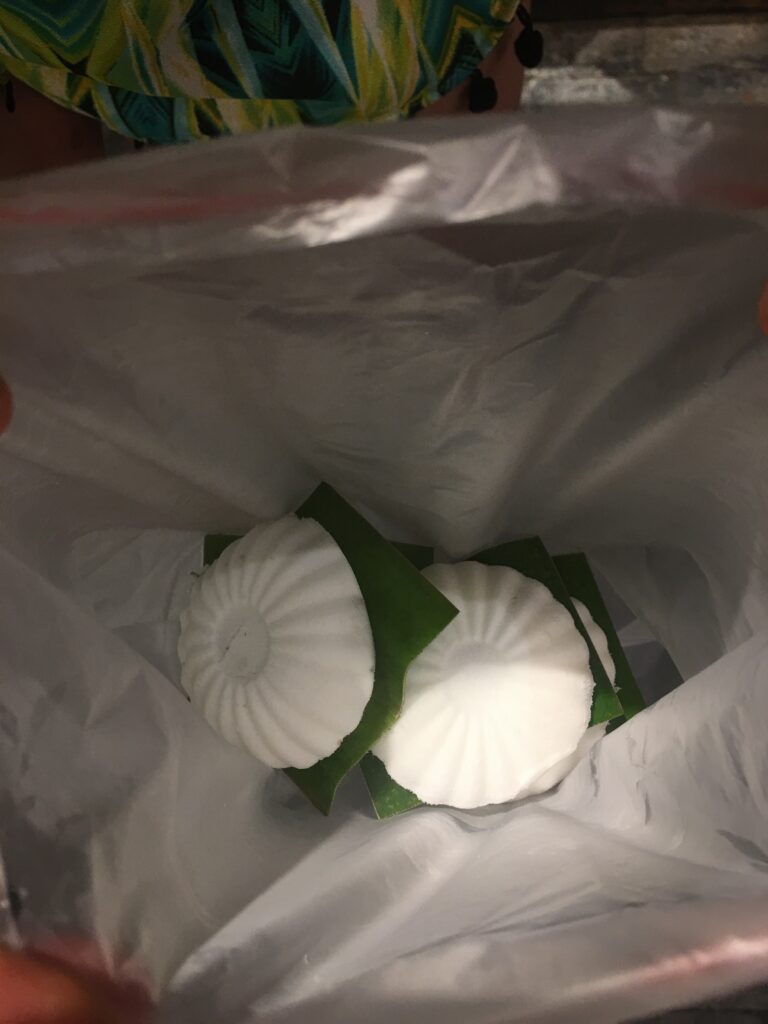
Munch on colorful, bite-size snacks or desserts that are chewy and satisfying.
There are savory and sweet kues, and locals love both kinds. The term Kueh in Indonesia and Singapore, and Kuih in Malaysia, derives from the Chinese word 粿 (Mandarin: guǒ), which means “cooked rice used for cakes.” Usually, the term refers to any snack, cake, biscuit, etc., made from rice or glutinous rice. Additionally, sweet versions are made with coconut and gula malaka, or palm sugar. It’s the perfect sweet bite paired with kopi or teh and is found everywhere in Singapore.
Some of the more popular sweet kues include kueh lapis, kueh tutu, and kueh dadar. My personal favorite is kueh tutu, which is a small steamed rice snack that can be unfilled or filled with gula malaka and sometimes peanuts. It’s the perfect texture: slightly chewy with crunchy sweetness. My favorite savory kueh is chwee kueh, which is a steamed rice cake topped with preserved radish. It’s made to be bite-sized and served on a large paper. It’s so nourishing and flavorful; the preserved topping provides all the flavor, and the steamed rice cake is the perfect vehicle for flavor.
Where to Try: You can get sweet kuehs pretty much anywhere. But my favorite place to get chwee kueh is at Jian Bo Shui Kueh at Tiong Bahru Food Centre. They’re a famous chwee kueh stall that opened in 1958 and has been family-run for three generations already. It’s 3 SGD for five pieces and 6 SGD for 10, but 5-8 is more than enough to fill you up.
16. Curry Puffs
One of Singapore’s best-kept snack secrets.
Contrary to popular belief, curry puffs are not Japanese, at least not the ones in Singapore. Legend has it that the first curry puffs in Singapore were made during the British colonial era when Indian cooks fused Western pastries with their curries. But the first place to create and sell curry puffs was the Polar Cafe.
In 1926, Chan Hinky opened Polar Cafe and churned out spicy chicken curry puffs. Apparently, Chan’s wife got the recipe from a friend. The curry puff was so popular that large hotel and restaurant chains began offering their own versions of curry puffs. In 1986, Old Chang Kee brought the deep-fried curry puff to the market and is now a local brand-name vendor for the famed pastries. Now, it’s a popular snack for parties and picnics due to its portability.
There are dozens of curry puff varieties, ranging from the shape and dough to the filling. Some curry puffs contain chicken and onion, others with potatoes or eggs. Curry puffs can also be baked or fried. But no matter the kind, curry puffs are always golden brown on the outside and nice and hot on the inside with tasty fillings. It’s the perfect snack or on-the-go breakfast.
Where to Try: Try Singapore’s famous curry puffs at Old Chang Kee. There are dozens of outlets peppered around the island and you can’t go wrong at any of them. Each curry puff is about 2-3 SGD.
Beverages
17. Mr. Coconut Singapore
Refreshing coconut drinks and smoothies from an adorable coconut mascot.
When it’s 28-30 C degrees outside, and you’re hot and sweaty, nothing tastes better than a refreshing coconut smoothie. Mr. Coconut is a famous Singapore brand that started in 2016 when the founders went on a business trip to one of their hometowns, Malacca, Malaysia. They enjoyed a coconut shake that had not yet been introduced to the Singapore market, so they brought it to Singapore. The beginnings of the business were shaky when the shop had a different name and fierce competition from the then craze: bubble tea. However, the brand exploded in popularity during the pandemic thanks to social media marketing, and it eventually became the new “it” beverage. Now, Mr. Coconut has 49 outlets over the island and is still expanding today.
The brand prides itself on serving refreshing coconut drinks fresh to order. Its coconut shake is the number one most popular drink, which is made with fresh young Thai coconuts, fresh coconut juice, ice, and ice cream. The shake is refreshing, creamy, and has an amazing milkshake-like texture and tastes best right when you get it. It’s every young Singaporean’s favorite drink (besides coffee and tea), and Mr. Coconut stands will often run out at the end of the day. That’s what happened to my friend and me when we tried to get one at Sentosa! Luckily, we returned 2 hours later, and they restocked. It just shows how popular they are!
Where to Try: You can get Mr. Coconut anywhere across the island. At the mall or near the beach, it’s the perfect drink to grab on the way home or with friends.
18. Kopi and Teh

Drink coffee and tea like a local, with all the Malay words included.
Traditional Singaporean coffee shops demonstrate the combination of ethnic cultures in the country. Kopitiams are a baby of Malay and Hokkien, where kopi means coffee in Malay and tiam means shop in Hokkien. Singaporean coffee shops started with immigrants serving the European population in Singapore, using the coffee they had on hand and innovating the sock-coffee brewing method. Using cheap coffee, sugar, lard, or butter and straining with a sock, kopitiams create economical and tasty cups of tea and coffee.
Ordering kopi and teh is a whole other experience, where you use Singlish, a mix of the various languages found in Singapore, to order. It’s so complicated at first glance that there are hundreds of images made about the various varieties of kopi and teh and how to order them. For example, if you want an iced coffee with evaporated milk that is less sweet to go, you would say, “kopi c siu dai peng dabao.” Once you’ve practiced it a few times and get familiar with all the terms, it’s actually quite easy. However, the real challenge is getting used to ordering at lightning speed.
My Experience
My local friend and I were waiting in line at Ya Kun Kaya Toast, and she asked me what drink I wanted so she could order it for me. She explained that there’s a whole system and lingo for ordering kopi and teh in Singapore. Intrigued, I told her an iced coffee with milk and sugar, less sweet. When we got to the cashier, ready to order, she proceeded to converse with the cashier in Singlish at lightning speed. In awe, I could barely understand what she was saying, only catching certain Malay and Hokkien words here and there. I definitely would’ve froze trying to order kopi and teh for us, haha.
Where to Try: You can get kopi and teh literally anywhere, from specialty coffee shops to coffee stalls in food halls. Everyone should try kopi and teh from a food stand first, getting the authentic experience of talking to an uncle or auntie and sitting in the hawker center.
19. ABC Juice


The miracle drink.
Fresh juice is abundant in Singapore, where the weather is hot and humid all year long. A cold, refreshing drink is welcome at all hours of the day, and juice is a great way to replenish essential vitamins for hydration. I personally had never had ABC juice until I went to Singapore, but it seems like it’s a well-known combination in the juice community. ABC stands for apple, beet, and carrot juice! Apparently, this juice is full of vitamins and helps keep your gut healthy. But besides the benefits, this juice is literally the most refreshing thing on planet Earth.
The mixture of juicy apples, earthy beets, and slightly savory and sweet carrots make the perfect juice combination. It’s a juice with a rich mouthfeel, unlike straight apple or orange juice. The color is also so appetizing: a deep red-orange. Most, if not all, juice stands in Singapore press your juice fresh to order and served iced. After I had it the first time, I drank it almost every day on my trip… Maybe I was just dehydrated, haha.
Fresh juices are cheap in Singapore, too! At hawker centres, a large juice will be around 3 SGD. You can also get them from juice stores, but they charge more premium prices. But in my opinion, the best juices are from small stalls.
Where to Try: My favorite place for juice is Sunshine Fruit Juice in Tiong Bahru Food Centre. It’s a no-frills fresh juice stall that has a large menu. It’s stall #2-#07 on the left of the Jian Bo Shui Kueh stall. But juice is good from any hawker stall!
Dessert
20. Ice Cream Sandwiches


A block of ice cream in a rainbow slice of bread or thin wafers.
This is not like your regular ice cream sandwich. The ice cream sandwich is one of the most iconic desserts in Singapore. You’ll find unique ice cream flavors like durian, sweet corn, red bean, and taro, to classics like chocolate, mint chocolate chip, and vanilla. But that’s not the most interesting part.
When you walk up to an ice cream uncle or auntie, they’ll ask you what ice cream flavor you want. You pick the flavor you’d like, and then you’ll see them pull out boxed ice cream. They chop the ice cream right in front of you, with the box on and everything. The vendor peels the cardboard peel off of the rectangular piece of ice cream and asks you if you want bread or wafers on the outside. The bread is a rainbow-colored, soft piece of white bread that wraps the ice cream, much like a literal ice cream sandwich. If you’re not feeling the bread, you can choose thin wafers that protect your fingers from ice cream and offer a nice crunch.
Cheap Prices!
Best of all, these ice cream sandwiches are so. cheap. Each sandwich is traditionally 1 SGD, now 1.5 SGD, due to inflation, which affects Singapore food prices across the island. You’ll see ice cream carts around the island, especially in areas where there are high population densities. You can’t go wrong getting it from anywhere; look for the red carts with the red umbrellas that have the Wall’s logo, which is the ice cream brand. But behind the iconic snacks are the ice cream uncles and aunties who work them. Each has a unique story, and some have been doing it for decades!
Where to Try: Many Singaporeans recognize the faces of the ice cream uncle or auntie they frequent. One of the most iconic ice cream uncles is Uncle Chieng, who’s been selling on Orchard Road in front of Takeshiyama Mall since 1965—that’s 58 years!
21. Cendol/Chendol

Instantly cool off on a sunny day with this colorful, icy dessert.
Chendol is a popular layered shaved ice dessert all throughout Southeast Asia, but especially in Malaysia, Indonesia, and Singapore. It’s made with shaved ice, green (pandan) worm-like rice flour jellies (cendol), coconut milk, and gula malaka. The origin of this dessert goes back hundreds of years when food experts say that a Persian dish, Falooda, inspired the now cendol. Some also say that cendol’s twin dawet inspired it, dating back to ancient Javanese manuscripts. Regardless of how it appeared, variations of this dessert exist all over Southeast Asia: Vietnam’s che ba mau, Myanmar’s mont let saung, and Thailand’s lot chong.
The cendol itself doesn’t have a flavor; it’s mainly a grassy, chewy topping that acts as a flavor vehicle for the coconut milk and palm sugar. What makes Singapore’s version different is that you may find sweet red beans or mung beans as an additional topping. The palm sugar adds a nice smoky caramel flavor that is balanced with the rich coconut milk. The crunchy ice and chewy jellies make a perfect pair, and this dessert is beloved by Singaporeans and even the world! CNN Travel featured Cendol as one of the top 50 famous desserts in the world in 2023.
Where to Try: One of the most famous places to try cendol is at Four Season Cendol in Toa Payoh Lorong 8 Market & Hawker Centre. They’re known for their blended version of cendol, which becomes a refreshing sweet smoothie. It’s also totally customizable so that you can add your favorite toppings.
22. Durian

The forbidden king of fruits.
As we all know, durian is a spiky, melon-shaped fruit that is infamous for its smell. Some say it smells like trash, rotting food, or gasoline, but its tastes range in description. Many say that it tastes better than it smells, similar to that of a custard. It’s an incredibly divisive fruit with both lovers and loathers alike. It’s even banned on public transport in Singapore! However, the tropical weather in Singapore is the perfect growing environment for the king of fruits.
There are even varieties of durian that range in price, with the Tiger Black Gold durian being the most expensive and unique tasting. While durian is available in most Southeast Asian countries, there are certain varieties that are readily available in Singapore that are perfect for the durian lover. You can also find them sold in stands or find a durian delivery service (yes, they exist).
Where to Try: This is a hard one because durian is quite expensive and served pre-prepared or whole. If you’ve never tried it before, I would not recommend buying the fruit itself. I recommend trying durian in a dessert to gauge whether you might like it. You can find durian desserts everywhere in Singapore, from ice cream sandwiches to cakes and pastries.
23. Martabak Manis

Soft, sweet, fluffy, thick pancake… whisper more sweet nothings.
Martabak goes by a lot of names: Murtabak, Motabbaq, Matabbak, Mataba, and the list goes on. Martabak refers to any stuffed pancake of flat bread found all over the Middle East and South and Southeast Asia. It’s said to originate from Yemeni Arabs, where the word martabak means ‘folded’ in Arabic. Arab conquerors introduced this type of food to Indonesia, where it mixed with local cuisine to create different fusions. Indonesian immigrants then introduced martabak to Singapore.
In Indonesia, martabak is considered the king of street food, where you’ll find savory and sweet martabak from carts, stalls, and restaurants. The sweet martabak is entirely different from the savory martabak. It’s a sweet, fluffy pancake made from sugar, tapioca flour, butter, eggs, vanilla, coconut milk, and baking soda. There are a variety of fillings to choose from, the most popular being chocolate and/or peanuts. You can also try the Dutch-influenced filling, which is chocolate sprinkles, cheese, and condensed milk.
The resulting snack is soft and fluffy, with a (yet another) satisfying chew. The pancake itself tastes of vanilla and butter, which perfectly supports the stronger flavors of the filling. Martabak manis is also quite large and filling, so get one to share!
Where to Try: Smile Martabak is the most popular spot to get Martabak Manis. It’s also known for its savory martabak as well. Their pancakes are fresh and chewy, with people saying that it’s “sinfully good.”
Eat Your Heart Out in Singapore
Singapore is indeed the land of foodies. With so many different dishes to try, there’s no telling when the eating adventure ends. From South Indian roti to Malaysian satay, to Hokkien noodles, to Chinese burritos, to Indonesian desserts, Singapore food is a flavor wonderland. This is just the tip of the iceberg when it comes to all the food Singapore has to offer. Especially as globalization continues, there might be even more food fusion to come in the coming decades. So many innovative and beloved dishes were babies of mixed identities. Hopefully, this Singapore food guide helps you pick where to eat next! Happy travels!
Relevant Reads
The Best Things to Do in Singapore for Easy Planning



